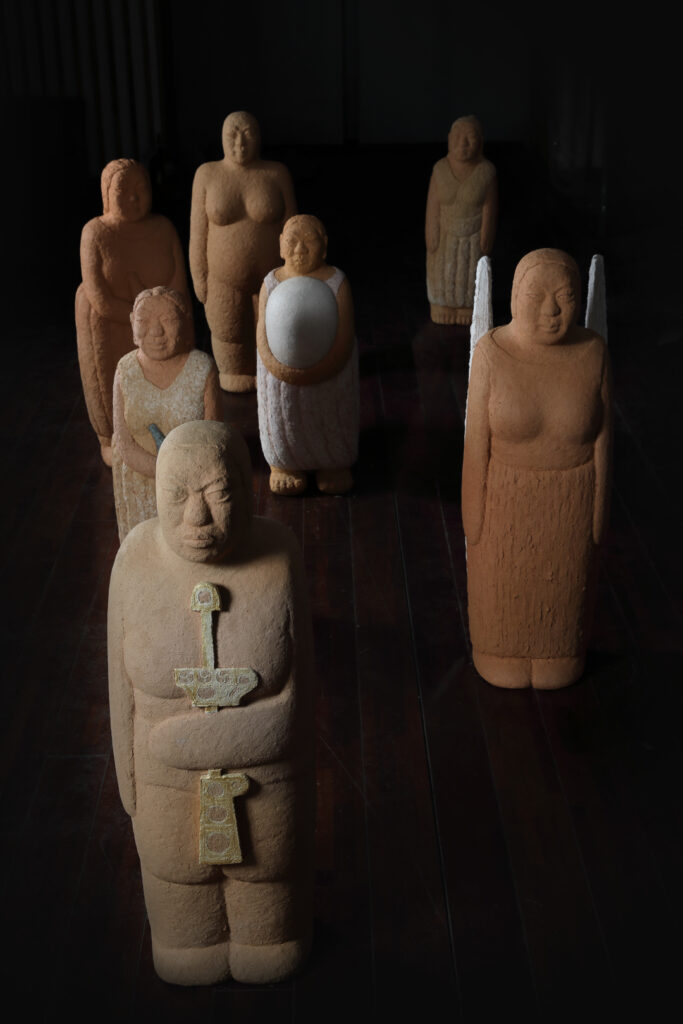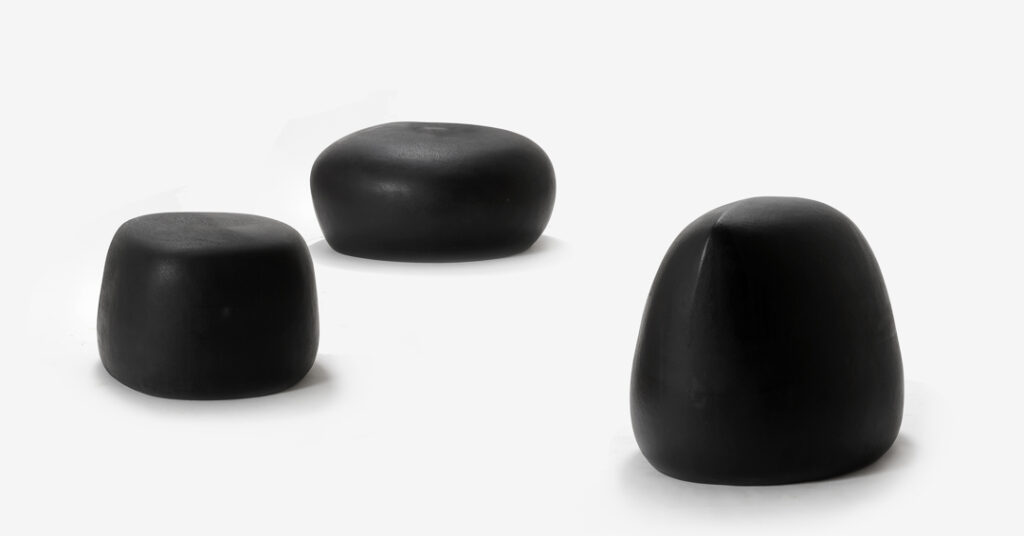Choi Leeji shares her vision of Korean ceramics, as it flows out of its traditional sources.
Self Medication: Korean Ceramic Art highlights the latest in contemporary Korean ceramic art, which has built a strong presence in the global topography of contemporary ceramic art by shedding light on different artworks, and in turn, explores the future of ceramic art and the core values that the ceramic art field as a whole, including that in Latvia, must strive for.
It is close to impossible to define contemporary ceramic art in succinct terms. Many genres of art are converging with clay as the medium, and the forms and expressions of ceramics are being reorganized and expanded. Meanwhile, media art, photography, and performance art are sometimes seen as new parts of ceramic art. However, the question remains whether the increased use of ceramics as a medium can in fact be seen as the fruits of ceramic art. Self Medication: Korean Ceramic Art is an attempt at determining the origin and center for Korean ceramics within the expanding borders of ceramic art, and aims to contemplate over the future direction for which Korean ceramics.
Contemporary Korean ceramics arose from the desire to reconnect with severed traditions when the country was left in disarray after independence and the subsequent Korean War (1950-1953). It began to take shape as the Korean ceramics scene started to embrace Western styles and ceramics courses were established in universities in the early 1960s. Most works were rooted in tradition until the early 1970s. However, rapid economic growth, changes in culture and the community, and increased international exchange led to form-centric ceramic trends beginning from the late 1970s into the early 1980s. Furthermore, as postmodernism began to take hold of the art world, including the ceramics field, more artists began to experiment with themes, materials, and techniques after the 1980s.
The National Museum of Modern and Contemporary Art, Korea held an exhibition entitled The Thirty Years of Korean Contemporary Ceramic Art in 1994, which was an overview of contemporary ceramics from an art historical point of view. Soon afterwards in 2001, the Gyeonggi World Ceramic Exposition was held with the aim of fostering the ceramics industry in Gyeonggi-do and promoting Korean ceramic culture around the world. The event allowed the Korean audience to share the expanded horizon of ceramics, rekindle their interest in ceramics, and became the chance for Korean ceramic art to find a home for itself on the world stage. Since the 2000s, Korean ceramics has been integrating new technologies and approaches to values, sensibilities, and media based on different cultures through exchanges with the outer world. Now, Korean ceramics is part of a wave of new culture and change as crafts, design, and the wider artistic realm intersect, overlap, and expand. Ceramic art, which set forth from the headwaters of traditional ceramics, has converged with different waterways and is now headed for the deep, wide ocean. Where are we heading now? If the sea is the scope of Korean ceramics, then what can we find in the deepest, most secretive depths of the ocean? Self Medication: Korean Ceramic Art poses questions to the ceramic art community as a form of medication for these questions and urges us to fiercely answer them.
- Yoo Euijeong (b.1981), Ego II. (2010), 74 x 34 x 34 cm
- Kim Jeongbum (b.1962), Guardian (2018), 150 x 250 x 37 cm
- Hahn Aikyu (b.1953), March (2022), 110 x 35 x 31 cm (7)
- Lee Dongha (b.1969), Celadon Three-legged Incense Burner (2022), 20 x 23.5 x 23.5 cm
- Bae Sejin (b.1981), WFG 272522-275497 (2019), 35 x 35 x 35 cm
- Oh Hyangjong (b.1964), Between (2017), 82 x 69 x 69 cm (4)
- Lee Neungho (b.1965), House (2021-2022), within 90 x 80 x 80 cm (3)
Tradition
Ceramics are mentioned without fail whenever the topic of Korean aesthetic tastes comes up. Korean ceramics have steadily grown by reflecting the sensibilities and spirits of former times. Tradition and culture are not things that are severed from the current time but instead are ever alive and well among us. The robust context of tradition in Korean ceramics, its style of expression, and traditional values as understood in modern times are not only important themes but also the archetype for creation and a source of inspiration. It also plays an important role in strengthening the identity of Korean ceramics in this age of globalization. Works by Kim Yikyung, Kim Jungok, Oh Hyangjong, Lee Dongha, and Ree Soojong involve studying tradition, interpreting and investigating traditional techniques and f forms, and pose the question: what is a new tradition that can be enjoyed today?
Process
To a ceramicist, raw clay is the most important, indispensable element. It is the first material they begin to explore, and the thing that they form the deepest relationship with. There is no one single way to form, glaze, and fire to create a piece of pottery. Instead, each individual artist must find their own path. This discovery is, in a way, their fate. Park Jongjin, Bae Sejin, Baek Jin, Yeo Byonguk, Yoon Junghoon, and Lee Neungho’s works, which involve unique methods of interpreting and using different materials, are realized in their works in the forms of unique formal language, very much like fingerprints. The method by which each of the artists manages the materials and processes is the ultimate goal of the artists and the essence of their work.
Message
Holding a meaningful conversation is much simpler than one may think. Listen to what the other person has to say, understand their intent, and then say something befitting the context. One should be able to wield the art of speech at times, in order to bolster one’s argument. However, ceramic art may have been caged in quiet thought. Communication skills have become a virtue and a merit, and thus, forming discourse out of the vast stories surrounding ceramics using sound rationality and airtight narratives is needed now more than ever. Kim Jeongbum, Yoo Euijeong, Oh Jeisung, Jeong Kwan, and Hahn Aikyu ponder over the different issues that surround our community, cultural phenomena, and contemporary ceramics, and thereby urge us to continuously ask questions and voice our opinions.
Compared to contemporary art, there is a sore lack of academic research and critical discussion on ceramic art. The definition, evaluation, potential, and outlook always come from the outside in, and contemporary ceramics’ half-hearted, hesitant voice wasn’t enough to persuade the rest of the world. Before seeking advice from the outside regarding how ceramic art may move forward (or perhaps drift forward) I hope that it regains recognition and gains the ability to foresee its own future prospects thereby getting the traction to move forward by its own accord. This is what Self Medication: Korean Ceramic Art aims to voice.
This exhibition is not about shedding light on the 16 Korean ceramic artists’ art-making processes, nor is it about learning about their worlds of art. These artists that represent 16 different facets of Korean ceramic art are case studies of artistic practice that push us all to apply ourselves and overcome hurdles. I hope that these examples can serve as a sort of nautical chart that enables us to review our perspectives and experiences, discovering and navigating pathways through each individual’s world. The new definition of ceramic art must be a home and an ecosystem for various artistic genres to live and coexist within, and a common pool or resource, entailing the concept of integration instead of division.
Choi Leeji is Curator, Gyeonggi Museum of Contemporary Ceramic Art
Self Medication: Korean Ceramic Art (5 October 2023 to 14 January 2023) is opened as part of the guest country exhibition at the Latvia Ceramics Biennale 2023









